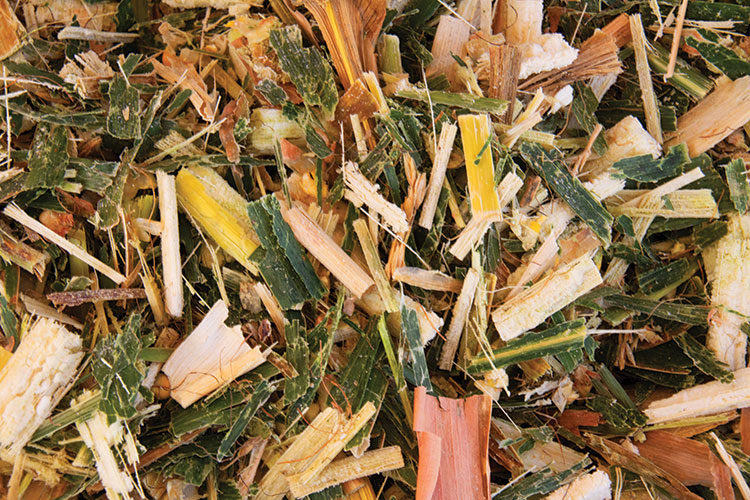
The underlying genetics of corn, or Zea mays, stem from domesticated teosinte found in Latin America thousands of years ago. There has been debate around this concept, but in the past 30 years, scientists have come to accept that today’s corn originated from southern Mexican regions.
Teosinte is a group of native annual and perennial grasses in Mexico. Much like corn evolved through domestication in Mexico, today’s dairy and beef cattle evolved under domestication many years ago while consuming grass and forage. Yet, today’s high-performing dairy and feedlot cattle cannot sustain and thrive on forage alone.
Corn is actually a grass, but we do not think of it as such due to corn’s high grain yield. When nutritionists or farmers discuss grass, the focus is typically around a cool- or warm-season grass such as Italian ryegrass, triticale, or sorghum. Despite not recognizing corn as a grass, we do think of corn as a forage. Herein lies a conflict. If corn silage is a forage, but we do not think of it as grass due to the grain, how do we define this feed in rations?
Many nutritionists and farms assign a 100% forage value to corn silage and then monitor the forage-to-grain or roughage levels in diets. The recognition of what corn silage brings to the ration can be improved upon.
Both stover and grain
Taxonomically, corn silage is a roughly 50:50 blend of grass stem and leaves to grain. The exceptional yield and efficiency that corn silage can bring per acre ties to the grain. So much so, that corn silage yield is typically around 50% or more driven by grain yield. Yield gains that plant breeders have been achieving also primarily come from grain. Further, many corn silage pricing efforts are determined based upon the grain yield.
The corn plant’s stem and leaves can be collectively referred to as stover. The stover brings fiber and energy to the diet as well. Some breeders have made efforts to separate the stover from the grain to evaluate corn silage nutrition characteristics with greater focus on each. However, separating stover from grain for silage testing takes considerable effort at half-milkline maturity and is not recommended.
Coming back to corn’s genetic blueprint, roughly 100 years of seed genetic advances have emphasized plant health, standability, grain yield, and other important characteristics. Corn breeders evaluate grain quality in their programs, but it’s important to note that grain quality desires for grain farmers equate to improved bushel weight, kernel density, and hardness factors relating to harvest and handling advantages. This is not the same grain quality needs we have for dairy or finishing beef cattle; in fact, it is just the opposite.
Grain hardness matters
When cattle consume a pound of silage or grain, the first step toward digesting feed in the rumen is the free-floating bacteria colonizing the feed particles. Many do not recognize that the free-floating rumen bacteria in liquid do the work, accounting for the feed’s initial digestion. Thus, the feed particles need to be soaked with rumen liquid prior to digestion, and corn grain is inherently not soluble in water or the rumen. In fact, the hardness factors that improve grain quality for grain farmers render grain less soluble in water and less accessible to rumen microbes.
The improved grain quality associated with high grain yields can actually be a negative for cattle performance. Substantial differences in grain hardness, or vitreousness, can equate to substantially different rumen digestion and energy potential, according to research published by the University of Wisconsin’s Randy Shaver and his colleagues. Kernel processing, fermentation, and grinding can partly overcome the grain hardness, but not entirely. Ask your nutritionist or seed adviser about grain quality.
Each has value
Coming back to the recognition that corn silage is a mix of forage and grain, consider treating it accordingly. Fiber and starch each contain the same number of calories, but ruminants are only able to unlock 40% to 50% of the calories in corn silage fiber. Fiber, alternatively, brings important rumen health aspects to your ration, which grain does not.
Ask your nutritionist what the roughage or forage level in your total mixed ration (TMR) would be if corn silage was split into a 50:50 mix of grain and forage. Beyond corn silage, other feeds can be a mixed bag of groceries when brought into the ration. Snaplage and earlage are also a blend of some stover and grain. These two feeds have far less stover and often are not considered forage at all, but may bring a small forage percentage into the diet.
Lastly, check with your nutritionist and recognize there are better ways to balance the fiber and rumen health aspects of your TMR than forage or roughage percentage. Your nutritionist is likely monitoring more important diet parameters, including neutral detergent fiber (aNDF), forage aNDF, or undigestible aNDF (uNDF240) levels. Balancing these fiber measures against other energy measures like starch or sugar will help your herd achieve exceptional rumen health and performance.
This article appeared in the March 2021 issue of Hay & Forage Grower on page 14.
Not a subscriber? Click to get the print magazine.

